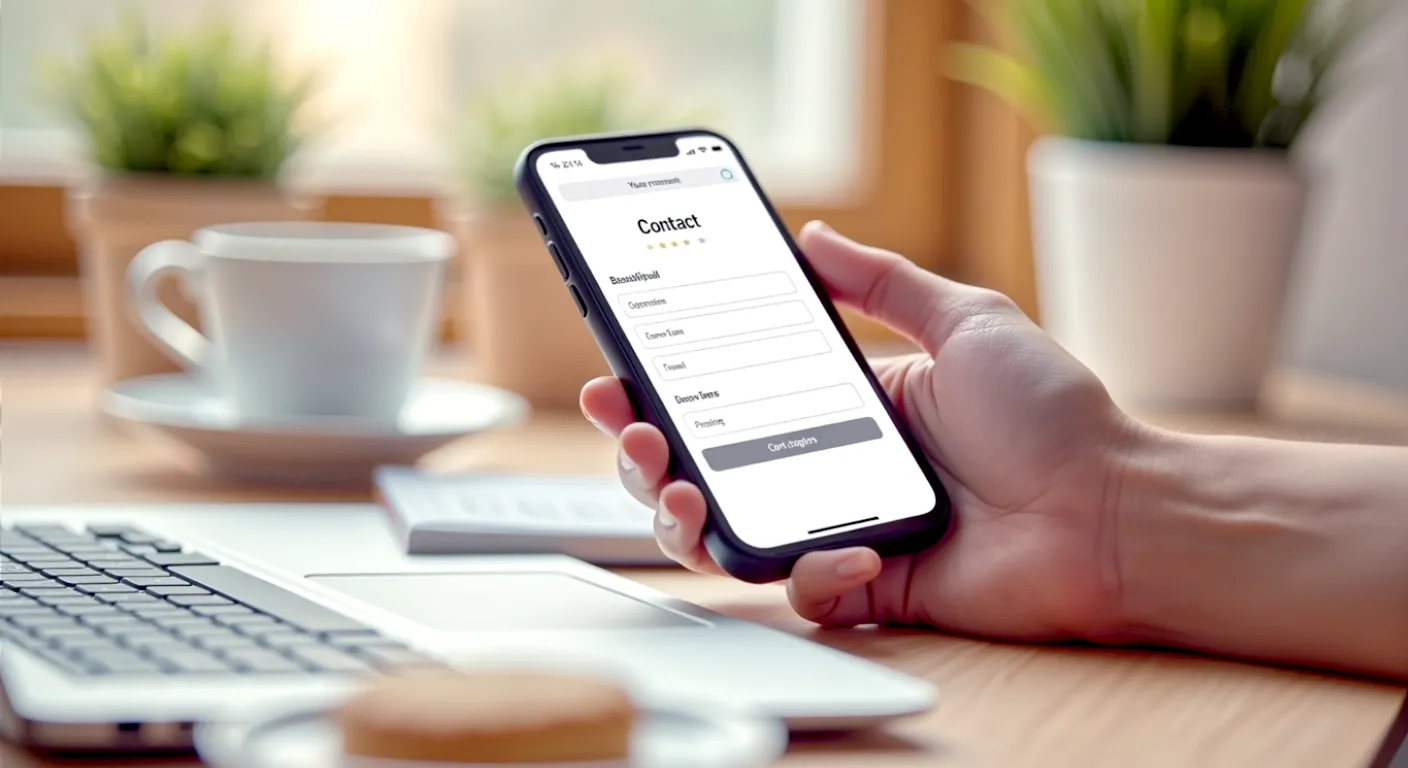The Guide to Creating a Contact Page That Actually Works
The ultimate UK guide to creating a contact page that builds trust and wins customers. We cover everything from legal must-haves to design secrets.

This post may contain affiliate links. If you make a purchase through these links, we may earn a commission at no additional cost to you.
Let’s be honest. We’ve all been there. You’ve got a burning question for a company. Maybe your newfangled gadget has decided to stop… gadgeting. Or perhaps you’re trying to give them your hard-earned cash, but their website is making it a Herculean task. You hunt for the ‘Contact Us’ link like a truffle pig on its last anadin. When you finally find it, tucked away in microscopic font in the website’s footer, you’re met with a page that’s about as helpful as a chocolate teapot. A single, mysterious email address. No phone number. No address. No clue if your message has been sent into the digital ether, never to be seen again.
It’s maddening, isn’t it?
For too long, the humble contact page has been treated as a chore. A box to be ticked. The last thing a business thinks about before launching their shiny new website. But here’s the secret: your contact page isn’t just a page; it’s a conversation. It’s your digital front door, your virtual reception desk, and your most important handshake. It’s where frustration turns into relief, curiosity into a sale, and a casual browser into a loyal customer.
In this guide, we’re going to give the contact page the love and attention it deserves. We’ll break down everything you need to know to create a page that’s not just functional, but genuinely helpful, trustworthy, and even a little bit brilliant. From the absolute must-haves for any British business to the clever design tricks that make people want to get in touch, consider this your ultimate blueprint. So, grab a brew, and let’s get started.
The Bare Bones: What Every Great Contact Page Must Have
Before we get into the fancy stuff, let’s nail the basics. Think of this as your non-negotiable checklist. Getting these elements right is the foundation of a trustworthy and effective contact page. Miss any of these, and you’re essentially telling your visitors you’d rather they didn’t bother you.
Your Name, Rank, and Serial Number: Basic Business Details
This might sound obvious, but you’d be surprised how many sites get it wrong. Clarity here is king, and for UK businesses, some of this information isn’t just good practice—it’s the law.
- Business Name: Clearly state the name you trade under. If it’s different from your legally registered name, it’s good practice to include that too, perhaps in the footer.
- Registered Office Address: If you’re a limited company in the UK, you are legally required to display your registered office address on your website. It’s a massive trust signal. It tells people you’re a legitimate, registered entity and not just a fly-by-night operation.
- Company Registration Number & VAT Number: Like the registered address, these are crucial for transparency and trust. For any potential business-to-business (B2B) client, not having these readily available is a red flag. Pop them in the footer of the page or near your address details.
Let’s Have a Chinwag: Multiple Ways to Get in Touch
People have different preferences for communication. Some want to pick up the phone and speak to a real person, while others would rather fire off an email at their convenience. A great contact page caters to everyone.
- Phone Number(s): The simple act of providing a phone number shows you’re open and accessible. It says, “We’re real people, and we’re here to talk.”
- Make it clickable: On mobiles, your phone number should be a ‘tel:’ link, so a user can tap it to call you directly. It’s a small detail that makes a huge difference.
- Use the right number: If you’re a local plumber in Penzance, a local
01736number builds local trust. If you’re a national e-commerce brand, a Freephone0800number might be more appropriate. Avoid premium-rate numbers unless absolutely necessary—they can feel like a penalty for customers seeking help.
- Email Address: A classic for a reason. Provide a clear, clickable
mailto:link.- Think about the destination: Instead of a generic
info@yourcompany.co.uk, consider using role-based addresses likesales@,support@, orhello@. This not only helps you internally by directing queries to the right team but also helps the user frame their message.
- Think about the destination: Instead of a generic
- Physical Address & Map: If you have a physical location that customers or clients can visit—a shop, an office, a showroom—an address is essential.
- Embed a Google Map: Don’t just write the address; show it. An interactive, embedded Google Map is now standard practice. It allows users to get directions with a single click.
- Boost your local SEO: Having your address clearly listed helps search engines like Google understand where you are, which is vital for appearing in “near me” searches.
The Digital Postbox: The Contact Form
While listing an email address is good, a contact form is often better. Why? Two main reasons: it cuts down on spam emails harvested by bots, and it allows you to structure the information you receive. You can guide the user to provide the exact details you need to help them efficiently. We’ll do a deep dive into mastering the contact form later on.
Opening Times: When Can People Reach You?
This is one of the simplest yet most effective things you can do. Managing expectations is the secret to great customer service. Clearly stating your business hours prevents the frustration of someone calling and getting no answer.
Be specific. Don’t just say “Monday to Friday.” Say “Monday to Friday, 9:00 am – 5:30 pm.” And don’t forget to include the time zone, especially if you have international customers. For a UK business, that’s GMT or BST.
Beyond the Basics: Elevating Your Contact Page from Good to Brilliant
Okay, you’ve got the essentials nailed. Now, how do you transform your page from a functional directory listing into a genuinely helpful and brand-building asset? This is where you add personality, anticipate needs, and make the experience seamless.
Set the Tone: Writing Copy That Sounds Like You
The words on your contact page matter. They should sound like they’ve come from your brand, not from a corporate robot.
- Find your voice: Are you a cheeky, playful brand or a formal, professional consultancy? Your tone should reflect this. A friendly “Get in touch for a chinwag” works for one, while “For all professional enquiries, please use the form below” works for another. Consistency is key.
- Use a clear Call to Action (CTA): The buttons and links on your page should be clear and action-oriented. Instead of a boring “Submit,” try something that relates to the user’s goal: “Send My Message,” “Get a Free Quote,” or “Ask a Question.”
- Tell them why they should get in touch: Frame the contact process around their needs. For example:
- “Got a question about your order? We’re here to help.”
- “Ready to start your project? Let’s talk about how we can bring your vision to life.”
- “Facing a technical hiccup? Our support wizards will get you sorted.”
FAQs: Answering Questions Before They’re Asked
Think about the top three to five questions your customer service team answers every single day. Chances are they are things like: “Where is my order?”, “What is your return policy?”, or “Do you ship to Northern Ireland?”.
By including a small, well-curated Frequently Asked Questions (FAQ) section directly on your contact page, you can solve common problems instantly. This has two huge benefits:
- It gives the customer an immediate answer, which is a fantastic experience.
- It frees up your phone lines and inbox for more complex, specific queries that actually require a human touch.
Meet the Team (or the Right Department)
For many businesses, especially service-based ones, people buy from people. Putting a face to a name can be incredibly powerful for building trust.
Consider including a small section with photos and names of key contacts. It doesn’t need to be the whole company, perhaps just the head of customer support or the new business manager. It makes the company feel more human and approachable.
If you’re a larger organisation, you can guide users to the right place. For example: “For all press enquiries, please contact Sarah in our marketing team. For questions about your bill, David is your man.”
Links to the Socials: Continue the Conversation Elsewhere
Your contact page is a hub. From here, you can direct people to other places where they can interact with your brand. Include clear, simple icons linking to your active social media profiles. If you haven’t posted on Twitter (now X) since 2019, don’t link to it. Only point people to platforms where you are genuinely present and engaging.
Designing for Humans: User Experience (UX) is King
A contact page can have all the right information, but if it’s a dog’s dinner to look at and a nightmare to use, people will give up. Good design is about making the process of getting in touch as easy and painless as possible.
Keep It Simple, Silly: Layout and Navigation
The best contact pages are often the simplest. Your goal is clarity, not clutter.
- Follow the ‘KISS’ Principle (Keep It Simple, Silly): Don’t make people hunt for information. Use clear headings, plenty of white space, and a logical structure.
- Use a common layout: A popular and effective layout is a two-column design. On one side, you have your contact details (phone, email, address), and on the other, you have your contact form or an embedded map. It’s intuitive and easy to scan.
- Make it findable: The link to your contact page should be screamingly obvious. The two most common and expected places for it are in your main navigation menu at the top of the site and in the website footer. Have it in both.
Looks Matter: Visual Design and Branding
Your contact page is still part of your website and your brand. It should look and feel that way.
- Be consistent: Use the same colours, fonts, and logo as the rest of your site. A jarring change in design can be disorienting and feel unprofessional.
- Use imagery wisely: A high-quality photo can make a world of difference. If you have a physical shop, show a welcoming picture of the storefront. If you’re a service business, a professional photo of your team can build instant rapport. Avoid sterile, generic stock photos at all costs.
The Mobile-First Mantra: Acing the Small Screen
In 2025, it’s a given that most of your visitors will be using a mobile phone. Your contact page absolutely must work perfectly on a small screen. This isn’t a “nice-to-have”; it’s essential.
- Test it yourself: Open the page on your own phone. Can you read the text without pinching to zoom? Are the buttons big enough to tap with your thumb?
- Clickable numbers are a must: As mentioned before, phone numbers should be tappable to initiate a call.
- Design forms for thumbs: Form fields should be large and easy to select. Typing on a phone can be a faff, so keep the form as short and simple as possible.
Mastering the Contact Form: Your Unsung Hero
A well-designed contact form is a thing of beauty. It guides the user, collects the right information, and filters out the noise. A bad one is a one-way ticket to an abandoned message. Here’s how to get it right.
What to Ask: Choosing Your Form Fields
This is the golden rule of contact forms: only ask for what you absolutely need. Every extra field you add is another reason for someone to give up.
- The Essentials: For most businesses, this is simply Name, Email, and Message. That’s it.
- Optional Extras (use with caution):
- Phone Number: Only make this a required field if you genuinely need to call them back. Otherwise, keep it optional.
- Dropdown Menu/Subject Line: This can be very useful for directing enquiries. A simple dropdown with options like “Sales Enquiry,” “Technical Support,” or “General Question” helps you categorise messages before they even hit your inbox.
- Resist the temptation to ask for their life story. You don’t need their address, job title, or inside leg measurement just for them to ask a simple question.
Fighting the Robots: Spam Prevention That Doesn’t Annoy Humans
If you put a form online, spam bots will find it. It’s an unfortunate fact of digital life. The challenge is to block the robots without irritating the real humans.
Those awful, squiggly text images (known as CAPTCHAs) are a user experience nightmare. They are often impossible to read and can be a major barrier, especially for users with visual impairments.
Thankfully, there are much better, modern solutions:
- Google reCAPTCHA (v3): This is the invisible one. It works in the background, analysing user behaviour to spot bots without requiring the user to do anything. It’s the gold standard.
- Honeypot Fields: This is a clever trick. You add an extra, hidden field to your form that humans can’t see but bots will fill in. If that field has an entry when the form is submitted, you know it’s a bot and can discard the message.
After the Click: The Thank You Message is Crucial
What happens after someone clicks “Send”? This is a critical moment that’s often completely overlooked. Don’t just reload the page or show a cryptic “Your message has been sent.” You can do so much better.
A great confirmation should do three things:
- Confirm receipt: A simple, clear message like, “Thanks for getting in touch! We’ve received your message.” This immediately reassures the user that the form worked.
- Set expectations: This is huge. Tell them when they can expect a reply. “A member of our team will get back to you within 24 working hours.” This stops them from worrying or sending follow-up emails an hour later.
- Suggest the next step: You have their attention, so use it! You could direct them to a helpful resource on your site. For example: “While you wait, why not check out our latest blog posts?” or “You can find answers to common questions in our Help Centre.”
This turns the dead end of a form submission into a positive, helpful brand interaction.
The Legal Bits: Staying on the Right Side of the Law (and Your Customers)
For any business operating in the UK, data protection isn’t optional. Getting this wrong can lead to hefty fines and, more importantly, a complete loss of customer trust.
Let’s Talk About GDPR
The General Data Protection Regulation (GDPR) might sound scary, but its core principle is simple: you need to be transparent and get clear permission before you use someone’s personal data.
Here’s how it applies to your contact form:
- You need a legal basis for processing their data. In the case of a contact form, the basis is usually “legitimate interest”—they’ve contacted you, so you have a legitimate reason to use their details to reply.
- You CANNOT automatically add them to your marketing newsletter. This is the big one. Replying to their specific query is fine. Adding their email to a marketing list requires separate, explicit, and affirmative consent. This means you need an unticked checkbox that says something like, “Yes, I’d love to receive marketing news and offers from you.” Pre-ticked boxes are a big no-no.
The All-Important Privacy Policy
Under GDPR, you are legally required to have a privacy policy and to link to it from your contact page. This link should be placed near the form’s submit button.
Your privacy policy is a document that explains, in clear language, what personal data you collect (e.g., name and email from the contact form), why you collect it (e.g., to answer their query), how you store it, and for how long. It’s all about being open and honest with your users.
Putting It All Together: Real-World Examples from the UK
Theory is great, but let’s see how it looks in practice.
The Good: A Look at Some Cracking Contact Pages
- A Creative Agency (e.g., MadeBrave): Often, creative agencies have brilliant contact pages. They’re visually engaging, the copy is full of personality (“Don’t be a stranger”), and they often provide multiple, clear ways to get in touch, guiding you based on whether you want to start a project or just say hello. They understand that the contact page is their first creative pitch.
- A Modern E-commerce Store (e.g., Allbirds): Good e-commerce contact pages are masters of efficiency. They’ll often have a prominent help centre or FAQ section to handle common queries about orders and returns. Their contact form might have a dropdown to categorise the issue, ensuring it gets to the right team quickly. They blend self-service with easy access to human help.
- A Local Tradesperson (e.g., a trusted local electrician): The best local service sites build trust. Their contact page will feature their phone number prominently. It will show their address on a map, include photos of their team or van, and feature testimonials or logos from trade bodies like Checkatrade. It’s all about saying, “I’m local, I’m real, and you can trust me.”
The Bad and The Ugly: Common Mistakes to Avoid
- The Scavenger Hunt: The contact link is hidden in the depths of the website.
- The Interrogation: A contact form with 15 required fields. Nobody has time for that.
- The Black Hole: A form with no confirmation message. Did it send? Who knows.
- The Ghost Town: Broken links, forms that produce an error, and an email address that bounces back.
- The Mobile Mess: A page that requires frantic pinching and zooming to navigate on a phone.
The Future is Calling: What’s Next for Contact Pages?
The world of customer communication is always evolving. While the core principles of a good contact page will remain, the tools we use are changing.
- Chatbots and Live Chat: For businesses that can support it, live chat offers instant answers. AI-powered chatbots can handle simple, repetitive queries 24/7, freeing up human agents for more complex issues.
- Social Media Messaging Integration: Many customers now prefer to contact brands via Facebook Messenger, WhatsApp, or Instagram DMs. Integrating these channels into your contact strategy simply meets your customers where they already are.
- Interactive Elements: Instead of a static page, we might see more interactive tools that guide a user to the right solution, almost like a digital triage nurse, before they even need to type a message.
Conclusion: Your Checklist for a Perfect Contact Page
We’ve covered a lot of ground, but it all boils down to one thing: making it easy for people to talk to you. A great contact page is a powerful tool for building trust, generating leads, and delivering brilliant customer service. It’s not an afterthought; it’s a priority.
Here’s your final checklist. Pin it to your wall.
- The Basics:
- [ ] Clear Business Name
- [ ] UK Registered Address and Company Number (if applicable)
- [ ] Clickable Phone Number (
tel:) - [ ] Clickable Email Address (
mailto:) - [ ] Embedded Map (for physical locations)
- [ ] Clear Opening Hours (with time zone)
- The Form:
- [ ] Keep fields to an absolute minimum (Name, Email, Message)
- [ ] Use modern, user-friendly spam protection (e.g., reCAPTCHA v3)
- [ ] Have a helpful confirmation message that sets a response time
- The Experience & Design:
- [ ] The page is easy to find (in main nav and footer)
- [ ] The copy matches your brand’s tone of voice
- [ ] It works perfectly and looks great on a mobile phone
- [ ] Consider adding an FAQ section for common queries
- The Legal Bits:
- [ ] Include a link to your Privacy Policy near the form
- [ ] Use an unticked checkbox for marketing consent (GDPR)
Get these things right, and your contact page will transform from a digital dead-end into your business’s most valuable conversation starter.
Further Reading & Resources
For those looking to dive even deeper, here are some highly respected resources in the world of web design, user experience, and digital marketing:
- Nielsen Norman Group: World leaders in user experience research. Their articles are the gold standard for usability.
- Smashing Magazine: An excellent resource for web designers and developers, with in-depth articles on best practices.
- GOV.UK – Setting up a business: The official source for understanding the legal requirements for UK businesses, including what you need to display on your website.
- Information Commissioner’s Office (ICO): The ultimate authority on GDPR and data protection in the UK.






